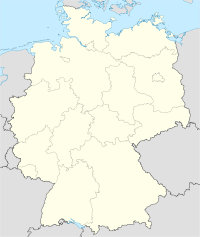- Munich Waldfriedhof
-
Munich Waldfriedhof Details Year established 1907 Country Germany Location Munich Type Public Number of graves 60,000 The Munich Waldfriedhof is one of 29 cemeteries of Munich in Bavaria, Germany. It is one of the larger and more famous burial sites of the city due to its park like design and tombs of notable personalities. The Waldfriedhof is widely considered the first woodland cemetery.
Contents
Description
The Munich Waldfriedhof is located in the southwest and borders several city districts today. It is separated in two sections, the old part and the new part (Alter Teil und Neuer Teil). It holds almost 60,000 graves. The Waldfriedhof is open every day from 8am and closes between 5pm and 8pm depending on the season. During the warmer months of the year the city arranges guided tours. The cemetery is connected to the public transport system MVV by several bus lines. Access to the graves by car is very limited. The cemetery borders the beginning Autobahn A95 in the south as well as other large roads in the north and east.
History
The Münchner Waldfriedhof as it is called in German was planned by the architect Hans Grässel and opened in 1907. In the years 1963-1966 the cemetery was enlarged by the architect Prof. Ludwig Römer.
The cemetery is one of a series of cemeteries in Munich planned by Grässel at about the same timepoint. The leaders of the city had not been fond of the idea of one huge main cemetery when the old burial sites became to small. Thus Grässel was instructed to plan four new cemeteries, one in each cardinal direction. The Waldfriedhof was created at a time when most cemeteries were designed as city parks or recreational parks. Typical themes of such cemeteries were "the City of the Dead" or "the Paradise Garden". As the new cemeteries were mostly placed in the outskirts of cities rather than as churchyards, and due to the diminishing importance of the church, they were comparably profane in character. To regain some symbolic strength, Grässel used influences from early Christian and Byzantine architecture in his funeral chapels and other buildings on the cemetery. He also put the burial chapel in the forest, rather than displaying it at the side of the avenue. Grässel kept the trees growing in the area, letting the woods cover tombs in order to create a feeling of connection between nature and death rather than letting the individual monuments be the main feature of the cemetery.
The themes and ideas from the Munich Waldfriedhof became popular in Germany in the upcoming decades and were used in several similar Waldfriedhöfe (woodland cemeteries) elsewhere. The Munich Waldfriedhof was also a very important predecessor of Skogskyrkogården outside Stockholm, a UNESCO world heritage site.
Selection of interred people
Notable burials include:[1][2]
- Stepan Bandera, Ukrainian politician
- Hans Baur, Hitler's pilot
- Günther Blumentritt, officer in World Wars I and II
- Michael Ende, author (e.g. The Neverending Story)
- Alfons Goppel, Prime Minister of Bavaria
- Hans Grässel, architect
- Paul Hausser, World War II General
- Werner Heisenberg, scientist and Nobel prize winner
- Barbara Henneberger, alpine skier
- Paul Heyse, writer and Nobel prize winner
- Kurt Huber, University Professor and member of the White Rose group
- Josef Kammhuber, Airforce General
- Carl Krone, founder of the Circus Krone
- Carl von Linde, engineer and inventor
- Wilhelm List, World War II Field Marshal
- Leni Riefenstahl, film director
- Josef Rodenstock, optician and founder of the Rodenstock GmbH
- Dietrich von Saucken, World War II General
- Franz Stuck, Art Nouveau painter
- Frank Wedekind, playwright and founder of the Simplicissimus
- Fritz Wunderlich, German lyric tenor
- Eduard Zorn, World War II General
References
- Official Homepage of the Waldfriedhof on Muenchen.de
- Constant, Caroline: The Woodland Cemetery, chapter 1. Byggförlaget 1994, ISBN 91-7988-060-6
Categories:- Buildings and structures in Munich
- Cemeteries in Germany
- Protected areas of Bavaria
- Visitor attractions in Munich
Wikimedia Foundation. 2010.

